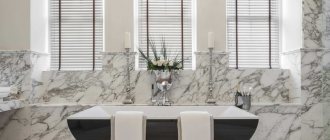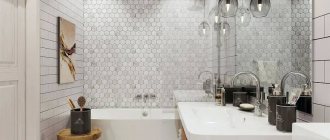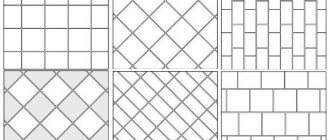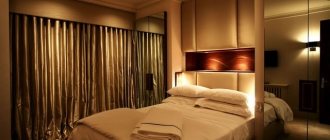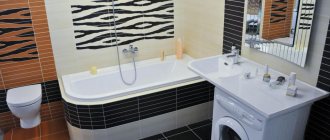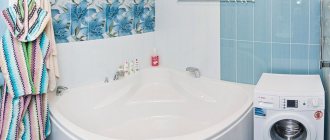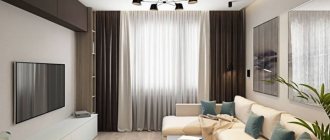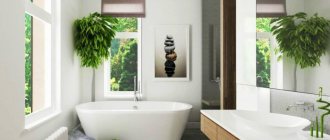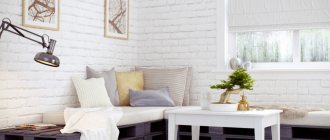Lighting in the bathroom needs to be thought out down to the smallest details. As a rule, there are no windows in this room, so there is no need to rely on natural light.
It is recommended to plan the layout of the lamps before the renovation, in order to immediately carry out the necessary electrical work and not damage the finish on the walls and ceiling. Then you need to decide on the number of lighting devices depending on the size of the bathroom. Next, you should think about the intensity of the illumination, choose the appropriate type of lamps and luminaires.
Lighting devices can be used for general lighting, illumination of certain areas or as decoration. In addition, do not forget about safety precautions, because electricity and high humidity pose a threat to life.
How to calculate the required number of lamps
To purchase the right number of lamps, you need to take into account the area of the bathroom. If the room is small (about 5 m²), then you can install 1 chandelier with two shades on the ceiling. For it, you can use ordinary light bulbs with a 60 W incandescent filament. In addition, you should think about additional lighting in certain areas, such as mirrors, sinks, bathtubs or shower stalls.
If the bathroom area is more than 6 m², then you will need 1-2 chandeliers for the main lighting and spotlights, spots or sconces to illuminate functional areas.
Important! The light above the mirror should be as natural and uniform as possible. White lamps are not suitable for illuminating this area, as they distort skin color, deepen shadows and tire the eyes.
To calculate the required number of lighting fixtures, you need to take into account the following indicators: illumination in Lux (Lux) and luminous flux per 1 m², the unit of measurement is Lm (Lumen). If the bathroom is small, then Lm and Lk are equal, for example, 200 Lm = 200 Lm/m².
If the area of the room is 5 m², then to illuminate it you need lighting devices of 1000 Lux. This value must be converted to W to find out the total power of the light sources. For example, a regular 75 W light bulb produces a flux of 935 Lm. This is enough to illuminate a five-meter bathroom.
To determine the power of lamps depending on the luminous flux, pay attention to the following indicators:
- 25 W – 220 Lm.
- 40 W – 420 Lm.
- 60 W – 71 Lm.
- 100 W – 350 Lm.
- 200 W – 2500 Lm.
- Halogen bulb (HL) 42 W – 625 Lm.
- 55 W – 900 Lumens.
- 70 W – 1170 Lm.
- GL (12 V) 65 W – 1700 Lm.
These indicators will help you determine the total power of the light bulbs and select the right type of light source. To do this, just calculate the area of the bathroom and the power of the lamp.
If you have chosen LED lamps, then you also need to know their power and luminous flux. For example, 10 W lighting fixtures emit 860 lm, which is enough for a room of 4 m². If the power of one lamp is 2.7 W, then you need to purchase 3 – 4 pieces. To calculate the number of lamps and lighting devices, divide the total power by this indicator of one device.
General provisions
What does the presence of light in the soul give?
The green light in the shower cabin will allow you to fully relax and get maximum pleasure from taking water treatments.
Mysterious lighting complements the design of a high-tech room
Optimal lamp type
When organizing lighting for a bathroom or toilet, you need to take into account the characteristics, pros and cons of different types of light bulbs.
There are the following types of lighting elements:
- Incandescent lamps are the most affordable light sources. However, their service life is no more than 1000 hours. They emit bright light, but heat up quickly, so they cannot be used for closed, plastic or textile shades.
- Halogen - their luminous efficiency is high, they last a long time. However, it is recommended to use them for lamps with a special metal diffuser. For lamps with a voltage of 12 V, a special step-down transformer is required, which is quite expensive.
- Luminescent - have a wide range of colors, they can emit daylight, warm or cold light. However, at low voltage they begin to glow dimly or turn off completely. In addition, their bulb is filled with mercury vapor, which is dangerous if the bulb breaks.
- An LED lamp is the best light source of all. They last about 50,000 hours, consume a minimal amount of electricity, have a wide spectrum of light, and emit a soft but bright light. Their only disadvantage is the high cost and the need to connect a power supply and dimmer. However, this disadvantage is compensated over time by saving energy.
Connecting the shower cabin to the electrical network
If a ready-made model purchased from a plumbing store is installed, then it is made as a single electrical appliance. The manufacturer has already taken care of the functionality of all the electrical components of the box, and during installation you just need to connect it to electricity. This stage is the final one, first you need to:
Each model has its own assembly features, which are described in detail in the instructions; if you follow its recommendations, then installing the shower stall should not cause much difficulty.
What type of lamp to choose
The lighting market offers a large number of different types of lighting devices that can be installed in the bathroom. Their choice depends on the design, method of fastening, size of the room, and material of the ceiling covering.
Depending on the method of placement on the ceiling, open and built-in models are distinguished. Large chandeliers are more suitable for spacious rooms with high ceilings, while spotlights are more suitable for a miniature room.
Depending on the location, there are ceiling, wall and floor lamps. Ceiling lighting will help to evenly illuminate the room, wall-mounted devices are used to highlight work areas, and floor-mounted ones provide various decorative effects.
To install the lamp correctly, choose it taking into account the ceiling covering. For a basic ceiling, ceiling lamps are more suitable; they have a base with holes for dowels and screws with which they are attached. Recessed, spotlights or LED strips are not suitable for a concrete ceiling.
Both built-in and suspended models can be installed on a plasterboard ceiling. Only the installation of the lighting device must begin before installing the plasterboard sheets. To do this, you need to install a special platform on the rough ceiling, and after installing the suspended ceiling, attach a lamp to it through a special hole.
Almost any model of lighting device is suitable for a stretch ceiling; the main thing is to maintain the distance from the light source to the decorative coating. The lamp is installed through the hole on the mounting platform under the PVC film.
When choosing a lamp for a bathroom, you need to take into account its protection index (IP). In addition to letters, the markings contain numbers that indicate the level of protection against solid particles and liquids.
Moisture protection level of lamps:
- 0 – not protected;
- 1 – does not allow drops falling vertically to pass through;
- 2 – protects against drops falling at an angle of 15°;
- 3 – does not allow splashes to pass through, the angle of incidence of which is 60° from the vertical;
- 4 – protects against drops from all sides;
- 5 – provides protection from jets pouring from all sides (low pressure);
- 6 – protects against the effects of strong currents;
- 7 – does not allow moisture to pass through even when temporarily immersed in water;
- 8 – sealed and waterproof lamp.
The marking of protected lamps may contain a third number, which indicates mechanical strength.
Depending on the humidity level, the bathroom is divided into 4 zones, for which you need to select a lamp with a suitable IP:
- Zone 1 is the “wettest” area, water flows here and steam is present. Usually located next to the bath or shower. It is recommended to use low-power devices (up to 12 V) with IP from 67.
- Zone 2 – high humidity, it is located above the bathtub and shower stall. The chandelier is affected by steam, drops and even jets of water. Choose devices with an IP of at least 45 and a power of up to 24 V.
- Zone 3 is an area 1.5 m from the second zone. Splashes fly onto the lamp, so its IP should be from 24.
- Zone 4 is the driest area, which is located three hundred meters from the third zone. Only steam reaches the lighting device, so the first digit may be missing, but the second must be greater than 1.
This information will help determine where to place the lighting equipment and what IP it should have.
Let's summarize
Lighting is usually located on the ceiling (in more rare cases on the walls), but this is far from the only placement option. The lighting on the floor of the room will look quite unusual and interesting - it is designed rather to transmit diffused, slightly dimmed light, which will allow you to relax in the bathroom after a hard day.
The bath itself can also serve as a source of light, along the perimeter of which a chain of light lights is built. This kind of lighting is intended precisely as additional lighting, which can be used for relaxation by turning off the main source.
If you have only one lamp, you won’t be able to change modes - what you have is what you have to use. Multiple lighting leaves the opportunity to choose according to the mood.
A very important area of the bathroom that needs to be illuminated especially brightly is the sink with a mirror above it. This is where we perform a lot of hygiene procedures, and we need to see our face clearly.
The lighting can be installed on the sides of the mirror, under it or above it. There are models of mirrors with already built-in lighting, and for ordinary ones you can purchase a separate lamp.
When choosing a lamp, pay attention to protecting its body from moisture: splashes can fall on the lamp at any time, especially when it is placed directly next to the sink and bathtub.
Often, instead of a mirror, an entire wall cabinet is purchased at once: the mirror doors, in which you can see your reflection, dissolve, and everything you need for washing, as well as cosmetic supplies, is stored inside. This “combined” option is quite convenient: it saves space, and the necessary items are always at hand.
Sometimes the shelves are located not inside the mirror, but on the side of it.
Most companies have thought out the issue of lighting this kind of items very well: LEDs are installed in the cabinet, directly on top, or along the perimeter of the shelves, providing an even light that does not hit the eyes.
If the bathroom cabinets are located separately, then you will have to think through the lighting for the shelves yourself. And it seems to me that it is necessary here. Often it is in such cabinets that huge reserves of all kinds of funds are stored, and no one wants to delve into the dark depths.
In addition to classic spot lighting, there are more elegant options - for example, transparent balls hanging from the ceiling give the room volume and look very gentle. But to install them you need fairly high ceilings, which not every home has.
The English style, which we wrote about earlier, goes even further and suggests hanging a luxurious crystal chandelier in the bathroom and placing sconces in the same style on the walls. The idea is quite controversial from a practical point of view, but it looks very nice.
Photos: homebuilding.co.uk, www.pinterest.com, happymodern.ru, ihouzz.ru, meekfamily.net, lwww.thayray.com.
How to properly position light sources in the bathroom
The location of the lamps must be correct so that the room is evenly illuminated and the light is not too intrusive. When creating a lighting scheme, you need to consider the following nuances:
- The bathroom should be illuminated evenly, so install several low-power lamps or 1 - 2 high-power lamps.
- Arrange lighting devices wisely so that they illuminate all functional areas.
- Install the lamps on the suspended ceiling at an angle, and not perpendicularly, otherwise the light will be reflected from the covering, and this is unpleasant for the eyes.
- Do not hang the lighting fixture above a mirror, as this will distort the display.
- To make the bathroom interior interesting, complement it with bright accents: multi-colored lampshades, colorful tiles.
- Connect lamps separately in groups so that you can turn them on individually.
General recommendations
The bathroom needs bright light
Good, bright background lighting is recommended for bathrooms. The minimum standard illumination according to SNiP and SanPiN is 300 lux.
Remember that the light level is affected by the color, material of the walls, floor and ceiling. Dark, rough surfaces absorb light, while smooth, light surfaces reflect. Moreover, reflected light from the walls and ceiling visually enlarges the space.
For bathrooms, especially large ones, it is important to illuminate the functional areas separately from each other.
Soft diffused lighting of shelves, bedside tables, and cabinets will add additional comfort and make it easier to find the things you need.
The size and design of the lamps must match the size and design of the interior.
Do you need ceiling lighting?
Overhead lighting may consist of one or more fixtures. In a small room you can install one lighting device in the shape of a plate, and for a large room a chandelier and several lamps are suitable.
When choosing lighting equipment, consider the material of the ceiling covering. Suspended chandeliers are suitable for concrete bases, and built-in models are suitable for plasterboard and PVC ceilings.
A spotlight that emits directional light is suitable for the bathroom. It makes it possible to adjust the direction of the light flow.
A crystal chandelier framed by a diode strip will look luxurious. You can also install one lamp in the middle of the ceiling, and use spotlights to highlight the hotel areas. If the room is small, then place built-in fixtures around the perimeter to get even lighting and visually make the ceiling higher.
Useful information on LED strips
This is an extremely convenient LED lighting option that is relatively inexpensive and easy to install. LED strips, also called LED strips, are polymer strips on which miniature LEDs with resistors are installed. The reverse side of the plank is usually equipped with an adhesive layer.
LED strip is a flexible plastic strip with LEDs installed on one side and an adhesive base on the other.
Installing such a tape is very simple: you need to glue the element in a suitable place and connect it to the power supply. The LED strip is divided into equal sections, each of which contains a certain number of LEDs connected in series.
The places for cutting this design have special markings. In bathrooms, only waterproof LED strips marked IP44 can be used. Such elements vary in power. There is a purely decorative option, and strong LEDs that provide a large amount of light.
Individual pieces of LED tape are connected using special waterproof connectors; cuts can be made strictly according to the markings applied by the manufacturer
There are single and multi-color LED strips. The latter have a slightly more complex structure: in addition to the general output, there are three more - one for each color.
When choosing an LED strip, you should take into account such an indicator as the density of LEDs, i.e. their number per meter. In addition, an adhesive layer is not always needed; there are designs without it.
Soldering of single-color strips of tape is soldered according to the “plus - minus” principle. When installing a multi-color tape, connect the areas indicated by the indices V+, G, R, B. To choose the right power supply and controller, you need to calculate the length of the tape and multiply this figure by the power of one meter.
Installing the LED strip is easy. To do this, you need to fix the tape and connect it to the power supply, controller and electrical network (+)
If the length of the structure exceeds 15 m, you will need to use another power supply, if the length is more than 30 m - two power supplies, etc. The connection of the network electrical wire is usually made to the contacts, which are designated as N and L. For multi-color tape, the controller is first installed.
If, when installing LED bath lighting with your own hands, you need to bend the tape, you should remember that the permissible bending diameter is 20 mm.
This type of lighting can be connected not only to a regular switch, but also to a dimmer for an LED strip. This device allows you to adjust the brightness of the LEDs. A portable remote control can be a convenient option for controlling the backlight.
When working with LED strip, you must strictly observe polarity, protect the structure from mechanical damage, and adhere to fire and electrical safety rules. If you intend to fix the tape on a metal base, you should first cover it with insulating material.
LED strip leaves wide scope for obtaining various effects when decorating the interior.
In addition to mirror illumination, it can be used:
- to decorate the ceiling around the perimeter;
- to effectively illuminate small shelves;
- for decorating a mirror;
- to visually highlight the bath;
- for arranging a false window, etc.
If you install LEDs under the bathtub, you can achieve the effect of the structure floating. A false window illuminated with an LED strip can become a stylish interior decoration and visually expand a small space. An interesting addition are luminous faucet and shower attachments.
If you place an LED strip at the bottom along the perimeter of the bath, you can achieve the effect of it floating. You can decorate other furnishings in a similar way.
Such elements are quite simple to install; they do not need to be connected to the electrical network. Of course, the listed techniques should be used sparingly so as not to spoil the appearance of the bathroom with unnecessary details. If there are too many elements, the backlight will simply merge into one unintelligible spot of light.
Illumination of mirrors, washbasin, other elements
The lighting of the mirror should be natural so that it does not distort the reflection. It is better to install the lamp above it, on the sides, or combine these 2 options. Choose lighting fixtures with white shades with a matte finish that emit soft light.
The LED strip can be installed under the sink or along the edges of the bathtub. Plates with diodes are used to illuminate niches, drawers with clothes, cabinets, or along the perimeter of the wall.
In the bathroom or shower, lamps help create a relaxing atmosphere. Several devices can be installed above the bathtub or in the shower stall.
It is not recommended to install the lamp under a mirror, otherwise the display will be distorted. For the same reason, you should not use colored light bulbs or lampshades.
Shower lamp: features of selection and connection
The presence of lighting in the shower room or cabin will allow you to take water procedures with greater comfort. But in the process of its implementation, it is necessary to remember the dangers of combining water with electricity.
In the article we will look at all the necessary safety measures, as well as step-by-step implementation of this task with your own hands.
Photo of an illuminated shower stall
Decorative lighting
If the bathroom has interesting architectural elements, then they can be emphasized with LED lamps. This lighting is used as decoration and helps create a unique design. Small lamps are installed on walls, in window sills or windows, steps, niches and even in the floor. On the modern market you can purchase tiles with built-in LED bulbs.
For floor lighting, small lamps with a durable body and a power of up to 5 W are used. They help give the interior uniqueness and visually make it wider. Diode strips with moisture protection are used to illuminate walls, plumbing fixtures and furniture.
Implementation
The first step is to choose which lights for the shower room you will use:
Types of suitable lamps
Point light sources
Tip: when purchasing point devices, be sure to make sure that their degree of protection against moisture corresponds to IP44. Otherwise, you will put yourself and your loved ones in danger.
LED waterproof lights for shower rooms can add fantastic appeal to the surrounding environment.
Thus, it turns out that spot lighting devices can flood the entire cabin or room with light, while LED ones will only create illumination of the objects in use, which, in general, will also be acceptable. The choice in this case depends more on your personal preferences (
Electrics and high humidity: safety rules
To avoid electric shock and extend the life of bathroom fixtures, you must follow the following recommendations:
- Entrust the creation of a bathroom lighting scheme to professionals.
- Buy devices with the required level of moisture protection.
- Metal parts of lighting equipment must be protected from destruction.
- Install low-power lamps (up to 12 W) in the bathroom.
- Buy devices with a closed lampshade.
- There should be no exposed filament lamps in the bathroom, as they can explode when exposed to moisture.
- It is better to install power adapters for lamps outside zone 4, that is, in the next room.
- Sockets and switches in the bathroom must have a moisture-proof housing.
- Do not install sockets in zones 1 and 2 of the bathroom.
Do not place exposed wires, extension cords or tees in the bathroom. Insulate the cables securely to prevent moisture from getting inside.
The most expensive bathrooms
Unfortunately, it was not possible to find the exact cost of expensive rooms (with one exception). However, the following are considered the most expensive bathrooms.
Shangri-La Hotel (Istanbul). There is a TV built into the mirror.
7-star Burj Al Arab hotel.
Parisian castle Chateau Louis XIV.
Room with a window at the Ritz-Carlton Hong Kong (China).
A mansion in California boasts a $9.9 million bath.
If we take an indispensable attribute of any room - the bathroom itself - then they are also made from a variety of expensive materials.
Fossilized Indonesian wood over 180 million years old.
Made in a single copy. Price: $1,740,000. It belongs to a certain billionaire from the United Arab Emirates.
The billionaire does not advertise his name, and rightly so. After all, the owner of another expensive gold bathtub lost it. The gold container was simply stolen from the Japanese Kominato Hotel. And it cost $990,000 and weighed 86 kg.
Golden bath
The original rock crystal font is the heaviest. It was made in three copies. Two of them were sold: to a Russian oligarch and an Italian socialite. The cost of the plumbing was $790,310. The third copy is still for sale.
Crystal Font
Relatively inexpensive, but very beautiful bathtubs are made of amethyst and malachite. They cost $122,000 and $222,000 respectively. They also have legs made of gold.
Homemade shower cabins for half the price: beautiful, simple, and “not like everyone else’s”
Long gone are the days when a real “Soviet” cast-iron bathtub was the number one goal for a person thinking about how to decorate a bathroom. Today, the modern market offers a lot of sanitary ware, ranging from acrylic and steel bathtubs to entire home complexes equipped with the most modern equipment for spa treatments. Moreover, in recent years there has been a tendency towards abandoning lying in the bath and replacing “splashing” with taking a shower. The fast pace of life in modern cities, fashion trends and the desire to reduce water consumption also have an impact.
In this case, homemade shower cabins are an excellent alternative to a bath.
The range of this popular device offered in stores is capable of satisfying the most demanding consumer, but there is a large group of people who are not satisfied with industrial designs.
Some people don't like the price, others don't like the appearance. After all, in a country house, and even in an apartment, you want something special - not like everyone else. In this case, all you have to do is roll up your sleeves and make a shower stall yourself.
From this article you will learn:
